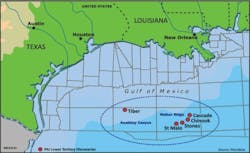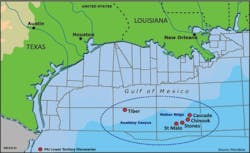Petrobras' Cascade & Chinook inaugurate FPSO production in GOM
BW Pioneer is first of its kind in US, world’s deepest ever
Eldon Ball
Senior Editor, Technology & Economics
Petroleo Brasileiro SA (Petrobras), the Brazilian oil company and operator of the Cascade and Chinook fields in the US Gulf of Mexico, says production will begin in early 2011, even though original plans called for first oil by the end of 2010.
When Cascade and Chinook begin production, Petrobras will become the first oil company to operate an FPSO-type production system in US waters. The Cascade and Chinook fields will employ shuttle tankers to transport produced oil and use self-sustainable submerged pumps and risers in the production train.
The FPSOBW Pioneer, constructed in Singapore at the Keppel shipyard, measures 241 m (791 ft) long by 42 m (138 ft) wide. It is moored in 2,600 m (853 ft) of water to a disconnectable turret mooring system that will allow it to disconnect in case of severe weather and later reconnect and continue operations.
Marginal ban effects
The Cascade and Chinook fields are located in the Walker Ridge block, around 300 km (180 mi) south of the Louisiana coast. Drilling at the two fields was affected marginally by President Barack Obama’s moratorium on deepwater drilling earlier this year, but did not result in significant delays to production start-up. Cascade and Chinook are in the process of entering production, according to Petrobras International Director Jorge Zelada, who spoke at a press conference recently in discussing Petrobras 2010-14 investment plans. According to Zelada, only a single well for the first phase of the Cascade/Chinook development plan was affected by the moratorium.
Petrobras is the operator of both units, with 100% ownership of Cascade and 66.67% of Chinook. Total E&P owns the remaining 33.33% of Chinook. Earlier this year, Petrobras exercised its rights to buy out former Cascade partner Devon Energy Corp., which previously held a 50% stake in the field.
The fields were developed using two subsea wells in Cascade and one subsea well in Chinook, approximately 30 km (18 mi) south of Cascade. Each well was drilled to an approximate depth of 27,000 ft (8,229 m), and based on reservoir performance, Petrobras may expand production to additional subsea wells on each field. Output from Cascade and Chinook is expected to reach 80,000 b/d, and is unlikely to exceed that amount until new drilling is allowed.
Under a $300-million contract from Petrobras, Technip provided for design, construction, and installation of five, free-standing hybrid riser (FSHR) systems and installation of infield flowlines and a gas export pipeline systems in waters from 2,515 to 2,740 m (8,251 to 8,989 ft).
For Technip, the Cascade and Chinook engineering, procurement, construction, and installation (EPCI) project brought together teams from across the world.
The Technip engineering center in Houston handled project management, engineering, and procurement with an integrated team of 60 engineers. Houston’s engineering efforts were supported by a design verification team from Seal Engineering (France) and technical assistance from Technip teams in Brazil and the Offshore Engineering Division in Aberdeen.
The FSHRs are the deepest ever and the first reeled ones, as well as the first in the GoM to be connected to an FPSO.
Technip’s spool base (in Mobile, Alabama) fabricated the pipes, and the Pori yard manufactured and assembled the buoyancy cans and suction piles.
Three years earlier, Technip had engineered and installed Brazil’s first FSHR in ultra deepwater for Petrobras’ PDET project on the Roncador field offshore Brazil.
Among the benefits of this technology, the company says, is that the system is tensioned by a buoyancy can, allowing the riser to support its own weight. This in turn reduces the weight supported by the production platform. Also, the riser is connected to the platform via a flexible jumper, allowing the platform’s motion largely to be disassociated from that of the riser. This makes the riser virtually insensitive to fatigue caused by wave motions. If a hurricane threatens, the FPSO can be moved off-station via a simple disconnection of the flexible jumper.
Each Cascade/Chinook FSHR comprises four, 630-m (2,067-ft) long, 7-in. (17.8-cm) ID flexible jumpers; one 630-m long, 6-in. (15.2-cm) ID flexible jumper; a 39-m (128-ft) long, 6.4-m (21-ft) diameter buoyancy can, with a top depth of 200 m (656 ft) and net uplift of 70 metric tons (77 tons); and production/gas export risers. Technip teams in Rio, Paris, and Aberdeen have worked together to optimize their resources for a successful installation of the high-pressure dynamic flexible riser system prior to the arrival of the FPSO.
The free-standing hybrid risers are used to transport oil and gas from the subsea flowline to the FPSO and gas from the FPSO to the export pipeline.
The second contract covers the installation of the Cascade infield flowlines and gas export pipeline and includes:
- Welding of approximately 120 km of 6-in and 9-in steel pipelines
- Design and fabrication of 10 PLET and 2 in line tees
- Installation of the pipelines and associated structures.
Offshore installation began in the third quarter of 2009, using Technip’s vesselsDeep Blue and Constructor.
KBR’s wholly owned subsidiary Granherne supplied engineering services for design of the hull for the early production system (EPS) and for the FPSO and later phase full field development (FFD).
Subsea contracts
FMC Technologies, under a $200-million contract from Petrobras, supplied subsea systems for the two fields, including four horizontal subsea trees, three manifolds, control systems, and two subsea horizontal electric submersible pumping systems that will boost production to the FPSO.
FMC sub-contracted Vertec for the supply of a variable speed drive (VSD) module under a $2-million contract. The VSD module consists of four high-voltage VSDs and other equipment to supply power to the two electric submersible pumping systems.
Heerema Marine Contractors handled installation of the Chinook flowlines in water depths of 8,000 to 8,800 ft (2,440 m to 2,680 m). The two 12 mi pipe-in-pipe flowlines include a 14-in casing pipe and a 9-in inner pipe.
Aker Solutions supplied subsea power cables and control umbilicals under a $65-million contract from Petrobras. The contract called for 230,000 ft (70 km) of high-voltage power cables and static and dynamic steel tube.
Advanced Production and Loading (APL), the technology division of BW Offshore, contracted subsea mooring specialist First Subsea to supply mooring connections for the disconnectable Submerged Turret Production (STP) Buoy. First Subsea provided mooring connections for a detachable submerged turret production (STP) buoy to APL AS. The mooring connections supplied by First Subsea include 11 Series II ball and taper connections.
Sonardyne International supplied an integrated acoustic positioning and telemetric system as a part of an extensive life-of-field integrity monitoring system for five free-standing hybrid risers. The deal was awarded to Sonardyne by BMT Scientific Marine Services, the systems integrator for the project.
Technip subcontracted Jumbo Offshore to provide support services during the execution of these contracts. Jumbo’s vesselFairplayer supported Technip’s vessel Deep Blue in installing the risers and other systems.
FPSO specifications
The FPSO is specified to have 600,000 bbl of oil storage capacity, 80,000 b/d of processing capacity, and natural gas export capacity of 16 MMcfd. It is moored by a polyester mooring system linked to torpedo piles and vertical loaded anchors.
Under a $740-million contract from Petrobras, BW Offshore was selected to convert, install, and operate the FPSO. The contract covered delivery and installation of the advanced production and loading (APL) disconnectable submerged turret production buoy and mooring system.
Bristol-based DPS was awarded the EPC contract for the crude stabilization and flare modules that form part of BW Offshore’s design. DPS was also responsible for managing the process and piping interfaces for the entire process topsides.
Offshore Articles Archives
View Oil and Gas Articles on PennEnergy.com



